Reasons Why Fall Protection Training is Critical to Your Construction Business

For some folks it is quite a common occurrence to search for images of construction site falls on the internet – just for laughs. But if you’ve ever been a victim of an on-the-job fall, you will understand there are some serious and even life-threatening issues that can come into play. Construction site falls are no laughing matter. Fall protection is a major source of OSHA violations, and a major consideration for a variety of businesses.
Let’s look closer at the basic facts of fall protection – this could make the difference between whether your workers clock out at the end of the day or end up in hospital.
What Is Fall Protection?
It doesn’t matter which industry you are involved in; thousands of falls are occurring every year. Workers from industries that are as different as chalk from cheese are faced with a high risk of falls.
While many workplace falls are minor, they can move up the scale to both serious and fatal. OSHA regulations are standards that are put in place to help prevent this hazard and involve the basics of workplace fall safety.
When Should I Have Fall Protection?
If your workplace has overhead platforms, confined spaces, or elevated workstations, often you will need a fall protection system in place. For example, in most situations, an elevation of four feet or more indicates the need for fall protection. In shipyards, this is five feet, on construction sites six feet and for long shoring operations, eight feet.
Four feet may not seem much, but you need to do the math: if someone weighs 200 pounds and falls from four feet, the force equivalent amounts to around 1,600 pounds. That’s quite a dent!
Therefore, OSHA have implemented the following requirements:
- Use railing and toe-board (or a floor hole cover) to guard every floor hole which could potentially become a fall hazard
- Ensure a guard rail and toe-board is provided around every elevated open-sided floor, runway, or platform
- If dangerous machines or equipment are present (such as a conveyor belt, or a vat of acid), it is imperative that the employer much provide guard rails and toe-boards, irrespective of the height.
Fall Protection Systems
Sometimes, specific equipment is required, such as line systems using fall arrest posts, or safety harnesses. These systems can be broken down into two main categories:
- Fall Protection Systems which are required in every circumstance where a worker is exposed to the possibility of a fall. The most common fall arrest system consists of an anchor, harness, and connectors. If a worker falls, these systems are designed to lock, thereby preventing an impact with the ground.
- Retrieval Systems are perhaps best described as the ambulance at the foot of the cliff: they’re designed to rescue a worker after a fall has occurred. There aren’t specific instructions given by OSHA on how retrieval systems should work, however they do insist that the employer has a plan in place. The two main methods of recover are hoists – which can be used to lift someone who has fallen – and poles. These are particularly useful when extracting someone from a confined space. You can find these systems from several companies.
The Numbers
Nearly 200,000 workplace injuries occurred in the US in 2018 attributed to falls. A total of 726 people died from falls on the job, which translates to nearly 2 people every day.
Following vehicle accidents, falls are one of the leading causes of death on the job. Construction sites are the main sector for nearly half of the fatal falls, but incidents are spread over many workplaces where you find potential fall hazards.
Those numbers are a sobering thought and emphasize how important fall protection is for your workplace. Any supervisor’s top responsibility is to ensure his workers can arrive home safely at the end of the workday. Fall protection training and the supply of fall protection equipment will help your construction company protect its employees.
Here at Safety Counselling, among our many other safety classes, we offer fall protection training. With our stellar track record of almost half a century, we are proud to continue to offer our fall protection classes each month and welcome your enquiries. Give yourself peace of mind knowing that you are following OSHA guidelines and doing everything you can to protect your workers by contacting us.
